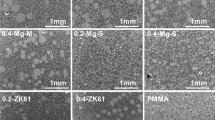Abstract
Conventional poly(methyl methacrylate)(PMMA) bone cement has been widely used as an useful biopolymeric material to fix bone using artificial prostheses. However, many patients had to be reoperated, due to the poor mechanical and thermal properties of conventional PMMA bone cement, which are derived from the presence of unreacted MMA liquid, the shrinkage and bubble formation that occur during the curing process of the bone cement, and the high curing temperature(above 100 °C) which has to be used. In the present study, a composite PMMA bone cement was prepared by impregnating conventional PMMA bone cement with ultra high molecular weight polyethylene(UHMWPE) powder, in order to improve its mechanical and thermal properties. The UHMWPE powder has poor adhesion with other biopolymeric materials due to the inertness of the powder surface. Therefore, the surface of the UHMWPE powder was modified with two kinds of silane coupling agent containing amino groups(3-amino propyltriethoxysilane(TSL 8331®) andN-(2-aminoethyl)-3-(amino propyltrimethoxysilane)(TSL 8340®)), in order to improve its bonding strength with the conventional PMMA bone cement. The tensile strengths of the composite PMMA bone cements containing 3 wt% of the UHMWPE powder surface-modified with various ratios of TSL 8331® and TSL 8340® were similar or a little higher than that of the conventional PMMA bone cement. However, no significant difference in the tensile strengths between the conventional PMMA bone cement and the composite PMMA bone cements could be found. However, the curing temperatures of the composite PMMA bone cements were significantly decreased.
Similar content being viewed by others
References
G. Khang and H. B. Lee,Biomedical Polymers, Munundang, Korean Chemical Society Press, 2002, pp 33-36.
L. Lindner,Acta. Orthop. Scand.,47, 3 (1976).
D. H. Yang, G. H. Yoon, S. H. Kim, J. M. Rhee, and G. Khang,Polymer(Korea),28, 77 (2004).
K. D. Park, G. Khang, H. B. Lee, and J. B. Park,Bio-Med. Mater. Eng.,11, 311 (2001).
(5)K. D. Park, J. Kim, S. J. Yang, A. Yao, and J. B. Park,J. Biomed. Mater. Res.,65B, 272 (2003).
Y. H. Kang and J. B. Park,J. Biomed. Mater. Res.,43, 261 (1998).
(7)B. V. Rejda, J. G. Peelen, and K. DeGroot,J. Biomed. Mater. Res.,22, 751 (1998).
J. M. Yang, P. Y. Hung, M. C. Yang, and S. K. Lo,J. Biomed. Mater. Res.,40, 361 (1997).
K. D. Park, Y. H. Kang, and J. B. Park,J. Long Term Eff. Med. Implants,9, 303 (1999).
G. Khang, Y. H. Kang, H. B. Lee, and J. B. Park,Bio-Med. Mater. Eng.,6, 335 (1996).
K. D. Park and J. B. Park,J. Biomed. Mater. Res.,53, 737 (2000).
J. Berzen, “Standardization of UHMWPE for Use as Implant Material”, inUltra-High Molecular Weight Polyethylene as Biomaterial in Orthopedic Surgery, H. G. Willert, G. H. Buchhorn, and P. Eyerer, Eds., Hogrefe & Huber Pub., Toronto, 1991.
I. Oh, T. W. Sander, and R. W. Treharne,Clin. Orthop. Rel. Res.,189, 308 (1984).
D. N. Hild and P. Schwartz,J. Mat. Sci.: Mater. Medicine,4, 481 (1993).
M. S. Silverstein, O. Breuer, and H. Dodiuk,J. Appl. Polym. Sci.,52, 1785 (1994).
C. M. Chan,Polymer Surface Modification and Characterization, Munich, Hanser Publishers, 1993.
K. T. Chu, Y. Oshida, E. B. Hancock, M. J. Kowolik, T. Barco, and S. L. Zunt,Bio-Med. Mater. Eng.,14, 87 (2004).
S. Saha and S. Pal,J. Biomech.,17, 467 (1984).
M. G. Hodosh, G. Shklar, and M. Povar,J. Biomed. Mater. Res.,9, 97 (1975).
K. Serbetci, F. Korkusuz, and N. Hasirci,Polymer Testing,23, 145 (2004).
J. M. Yang, C. S. Lu, Y. H. Hsu, and C. H. Shih,J. Biomed. Mater. Res.,38, 143 (1997).
J. M. Yang, C. S. Lu, Y. H. Hsu, and C. H. Shih,J. Biomed. Mater. Res.,48, 52 (1999).
E. A. Friis, F. W. Cooke, and H. K. Yasuda, inFifth World Biomater. Congr., Toronto, Canada, 913 (1996).
S. Pal and S. Saha,Biomaterials,3, 93 (1982).
A. Knoell, H. Maxwell, and C. Bechtol,Ann. Biomed. Eng.,3, 225 (1975).
S. Saha ans S. Pal,J. Biomech.,17, 467 (1984).
T. M. Wright and P. S. Trent,J. Mater. Sci.,14, 503 (1979).
H. C. Park, Y. K. Liu, and R. S. Lakes,J. Biomech. Eng.,108, 141 (1986).
Y. K. Liu, J. N. Park, G. O. Njus, and D. Stienstra,J. Biomed. Mater. Res.,21, 247 (1987).
L. D. T. Topoleski, P. Ducheyne, and J. M. Cuckler,J. Biomed. Mater. Res.,26, 1595 (1992).
J. L. Gilbert, D. S. Ney, and E. P. Lautenschlage, in20 th Annu. Meeting Soc. Biomater., San Francisco, 141 (1994).
C. A. Buckley, J. L. Gilbert, and E. P. Lautenschlager,J. Appl. Polym. Sci.,44, 1321 (1992).
B. Pourdeyhimi and H. D. Wagner,J. Biomed. Mater. Res.,23, 63 (1989).
J. Berzen, inUltra-High Molecular Weight Polyethylene as Biomaterial in Orthopedic Surgery, H. G. Willert, G. H. Buchhorn, and P. Eyerer, Eds., Hogrefe & Huber Pub., Toronto, 1991.
D. H. Yang, G. H. Yoon, S. H. Kim , J. M. Rhee , and G. Khang ,J. Biomed. Mater. Res. (Appl. Biomater.), accepted (2005).
D. H. Yang , G. H. Yoon , S. H. fnKim , J. M. Rhee , and G. Khang ,Bio-med. Mater. Eng., in press (2005).
D. H. Yang, G. H. Yoon, S. H. Kim, J. M. Rhee, and G. Khang,J. Biomater. Sci., Polym. Ed., in press (2005).
L. Qing, D. Jiang, D. E. Chambers, S. Debnath, S. L. Wunder, and G. R. Baran,J. Biomed. Mater. Res.,57, 384 (2001).
S. Debnath, S. L. Wunder, J. I. McCool, and G. R. Baran,Acad. Dental Mater.,19, 441 (2003).
D. L. Pavia, G. M. Lampman, and G. S. Kriz ,Introduction to Spectroscopy, Brooks/Cole, Duxbury, Heinle & Heinle, Schirmer, Wadsworth, and West, 2001, pp 72-74.
H. Le Chatelier,Compt. Rend.,196, 1557 (1993).
S. A. Yerby, A. F. Paal, P. M. Young, G. S. Beaupre, K. L. Ohashi, and S. B. Goodman,J. Biomed. Mater. Res.,49, 127 (2000).
Author information
Authors and Affiliations
Rights and permissions
About this article
Cite this article
Yang, D.H., Yoon, G.H., Shin, G.J. et al. Surface and chemical properties of surface-modified UHMWPE powder and mechanical and thermal properties of its impregnated PMMA bone cement V. Effect of silane coupling agent on the surface modification of UHMWPE powder. Macromol. Res. 13, 120–127 (2005). https://doi.org/10.1007/BF03219025
Received:
Revised:
Issue Date:
DOI: https://doi.org/10.1007/BF03219025




